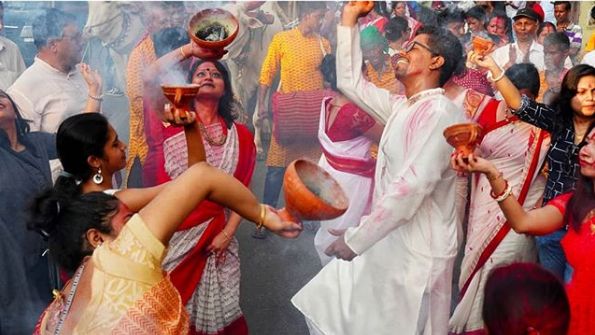Rooted in the mythological tale of Durga’s battle with Mahishasura, Dhunuchi Naach is believed to have emerged from early prayers meant to energize the goddess during her fight against evil. Over time, these quiet offerings evolved into rhythmic expressions of collective faith. The dhunuchi—traditionally made of terracotta or brass—holds burning coconut husk, camphor, and resin, its aromatic smoke symbolizing purification and divine presence. The act of dancing with this fire-filled vessel thus became not just ritual, but transformation—a way of becoming one with the divine offering.
 Historically performed in temple courtyards and household aartis, the dance found deeper roots in Bengal’s cultural fabric during the rise of sarbajanin or community pujas in the 20th century. What began as a ritual of the elite zamindars became democratized, transforming into a community performance open to all. Competitions on Ashtami and Navami nights popularized elaborate choreographies, with dancers taking on daring moves like holding three dhunuchis—one in each hand and one between their teeth—while spinning to the thunder of dhak and kansor ghonta.
Historically performed in temple courtyards and household aartis, the dance found deeper roots in Bengal’s cultural fabric during the rise of sarbajanin or community pujas in the 20th century. What began as a ritual of the elite zamindars became democratized, transforming into a community performance open to all. Competitions on Ashtami and Navami nights popularized elaborate choreographies, with dancers taking on daring moves like holding three dhunuchis—one in each hand and one between their teeth—while spinning to the thunder of dhak and kansor ghonta.
Perhaps the most striking evolution has been the role of women. Once a male-dominated ritual, Dhunuchi Naach now proudly features women performers, draped in white sarees with red borders, dancing with elegance and intensity. Their presence has not only redefined the aesthetics of the performance but also deepened its emotional resonance. The dance now reflects both strength and grace, echoing the very nature of the goddess it honors.
 Today, Dhunuchi Naach extends beyond the religious sphere. It is performed on stages, in cultural programs, and even featured in fashion shows as a symbol of Bengal’s living heritage. But its essence remains unchanged—a fiery celebration of victory, unity, and devotion. In the smoke and sound, performer and audience are transported into a sacred moment, where tradition dances alongside transcendence. This Puja, when the dhak booms and the dhunuchi blazes, you won’t just be witnessing a dance—you’ll be witnessing the heartbeat of Bengal.
Today, Dhunuchi Naach extends beyond the religious sphere. It is performed on stages, in cultural programs, and even featured in fashion shows as a symbol of Bengal’s living heritage. But its essence remains unchanged—a fiery celebration of victory, unity, and devotion. In the smoke and sound, performer and audience are transported into a sacred moment, where tradition dances alongside transcendence. This Puja, when the dhak booms and the dhunuchi blazes, you won’t just be witnessing a dance—you’ll be witnessing the heartbeat of Bengal.

/30-stades/media/media_files/hz4jqdObeOdaLkN7zp0E.jpg)



